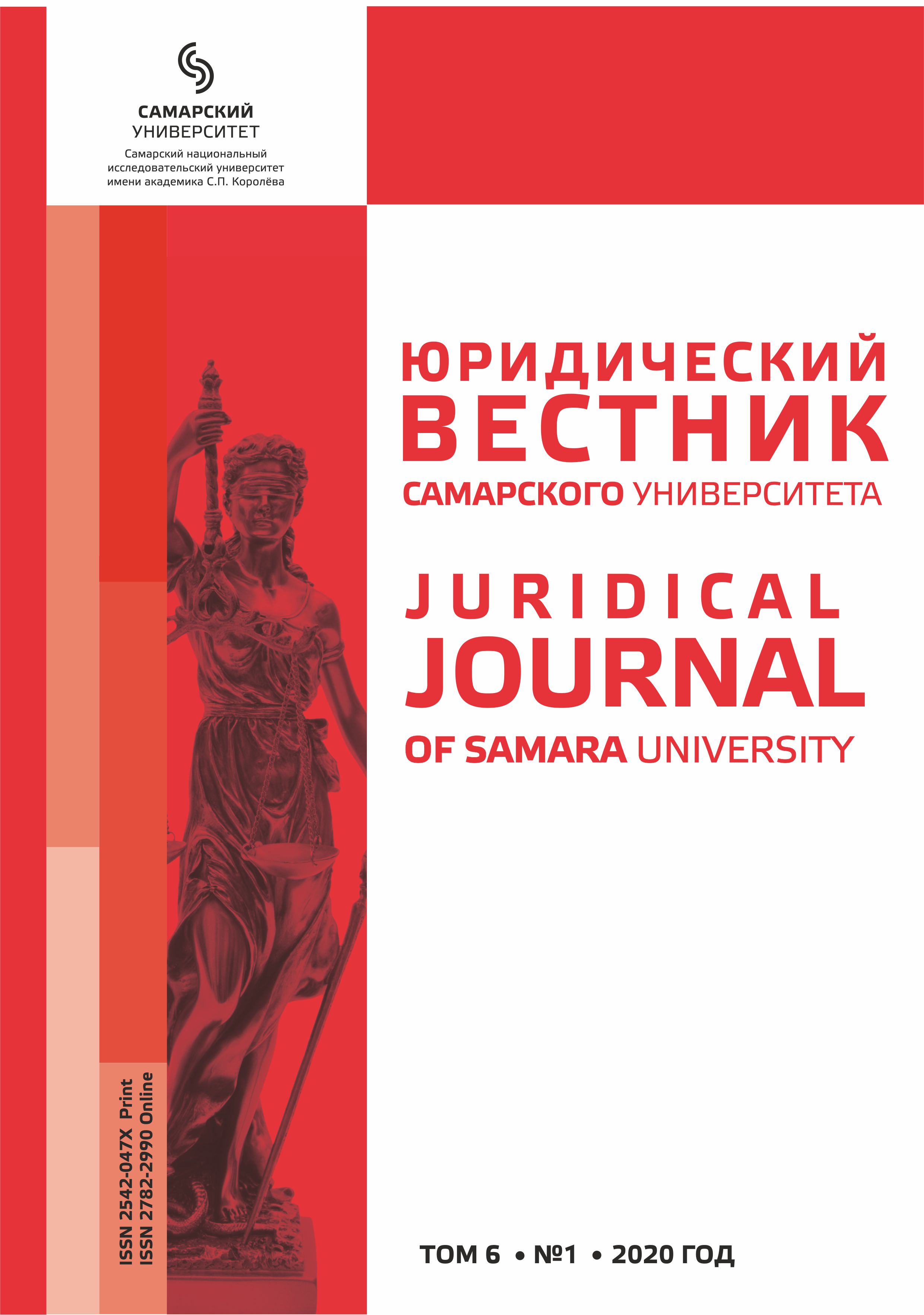ON THE DELIMITATION OF A SINGLE CRIME AND THE MULTIPLICITY OF CRIMES IN THE QUALIFICATION OF THEFT
- Authors: Bezverkhov A.G.1, Ivanova O.M.2
-
Affiliations:
- Faculty of Law, Samara National Research University
- Main Investigations Directorate of the Moscow Department of the Russian Ministry of Interior
- Issue: Vol 6, No 1 (2020)
- Pages: 47-53
- Section: Personalia
- URL: https://journals.ssau.ru/jjsu/article/view/7787
- DOI: https://doi.org/10.18287/2542-047X-2020-6-1-47-53
- ID: 7787
Cite item
Full Text
Abstract
The article is devoted to the theoretical and applied aspects of the qualifi cation of theft of other people's property on the grounds of multiple crimes. It is argued that before modern science of criminal law there are some pressing problems, to identify the most effective mechanisms to ensure the criminal-law protection of the new property law, which ultimately requires the design of completely new offences in the sphere of economic relations and the development of relevant emerging legal order of rules of qualifi cation of property crimes, including theft of another's property. The article analyzes the content of legal nature of the institution of multiple crimes and its forms of manifestation on the example of the qualification of theft of other people's property. Here the multiplicity of crimes is formed by identical, homogeneous, and heterogeneous acts. The social and legal signifi cance of the qualifi cation of theft based on the multiplicity of crimes is manifested in an increased degree of public danger to the person responsible and is refl ected in the appointment of a more severe criminal punishment for the crime as a whole. It is shown that bringing the content of the conceptual and categorical apparatus of the multiplicity of embezzlement, interfaced with each other and (or) with other crimes, in line with the emerging practice of applying criminal law is one of the most important tasks of the general theory of crime qualification and its section devoted to criminal legal assessments of theft of other people's property. It is established that the rules of delimitation of a single crime and multiple crimes in the classifi cation of theft of another's property as determined by legislation and the general rules of qualifi cation of crimes, developed a theory of criminal law. On the basis of general judicial explanations contained in the decisions of the Plenum of the Supreme Court of the Russian Federation on the qualification of theft of other people's property and related crimes, the trends of modern law enforcement practice are revealed. A real set of plunders of another's property be divided into (1) set of theft, defi ned according to the same article of the Criminal Code, (2) a set of theft falling under different Articles of the Chapter on Crimes against Property (Article 158–162, 164 of the Criminal Code), and (3) the set of plunders of another's property associated with crimes against persons, public safety, interests of service, etc.
About the authors
A. G. Bezverkhov
Faculty of Law, Samara National Research University
Author for correspondence.
Email: grigorjewa.katerina@yandex.ru
Russian Federation
O. M. Ivanova
Main Investigations Directorate of the Moscow Department of the Russian Ministry of Interior
Email: grigorjewa.katerina@yandex.ru
Russian Federation
References
- Malkov V. P. Institut mnozhestvennosti prestuplenii v doktrine i ugolovnom zakonodatel'stve Rossii [Institute of crime multiplicity in the doctrine and the Russian criminal law]. Aktual'nye problemy ekonomiki i prava [Actual problems of economics and Law], 2008, no. 4, pp. 179–
- Available at: https://cyberleninka.ru/article/n/institut-mnozhestvennosti-prestupleniy-v-doktrine-i-ugolovnom-zakonodatelstve-rossii [in Russian].
- Malkov V. P. Sovokupnost' prestuplenii [Totality of crimes]. Kazan: Izd-vo Kazanskogo un-ta, 1974, 308 p. [in Russian].
- Malkov V. P. Konkurentsiya ugolovno-pravovykh norm i ee preodolenie [Competition of criminal law norms and its overcoming]. Sovetskoe gosudarstvo i pravo [Soviet State and Law], 1975, no. 3, pp. 59–66 [in Russian].
- Malkov V. P. Mnozhestvennost' prestuplenii: sushchnost', vidy, pravovoe znachenie [Multiplicity of crimes: the nature, types, legal significance]. Kazan: Izd-vo «Taglimat» IEUiP, 2006, 141 p. Available at: https://b-ok.xyz/book/3002562/72fbea [in Russian].
- Pudovochkin Yu. Priznaki sovokupnosti prestuplenii v sovremennoi sudebnoi praktike [Signs of the totality of crimes in modern judicial practice]. Ugolovnoe pravo [Criminal Law], 2009, no. 4, pp. 54–59 [in Russian].
- Ugolovnoe pravo: v 2 t. T. 2. Osobennaya chast'. Otv. red. A. V. Naumov, A. G. Kibal'nik. 5-e izd. [Criminal Law: in 2 vols. Vol. 2. Special part. A. V. Naumov, A. G. Kibalnik (Eds.). 5th edition]. Moscow: Yurait, 2017, 499 p. [in Russian].
- Sheveleva S. V. Moshennichestvo v sfere komp'yuternoi informatsii: osobennosti kvalifi katsii i konkurentsii so smezhnymi sostavami prestuplenii [Fraud in the sphere of computer information: particular qualification and competition from adjacent structures of crimes]. Yuridicheskaya nauka i praktika: Vestnik Nizhegorodskoi akademii MVD Rossii [Legal Science and Practice: Journal of Nizhny Novgorod Academy
- of the Ministry of Internal Affairs of Russia], 2017, no. (40), pp. 229–234. Available at: https://cyberleninka.ru/article/n/moshennichestvo-v-sfere-kompyuternoy-informatsii-osobennosti-kvalifikatsii-i-konkurentsii-so-smezhnymi-sostavami-prestupleniy [in Russian].
- Sharapov R. D. Aktual'nye voprosy kvalifi katsii novykh vidov moshennichestva [Actual issues of qualifi cation of new types of fraud]. In: Problemy kvalifikatsii i rassledovaniya prestuplenii, podsledstvennykh organam doznaniya: mat. Vseros. nauch.-prakt. konf. [Problems of qualification and investigation of crimes under investigation by the bodies of inquiry: materials of the all-Russian research and practical conference]. Tyumen: Tyumenskii institut povysheniya kvalifikatsii, 2013, pp. 3–5 [in Russian].
Supplementary files










